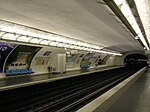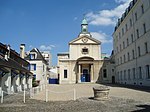Nation (Paris Métro and RER)
Commons category link is locally definedParis Métro line 1Paris Métro line 2Paris Métro line 6Paris Métro line 9 ... and 6 more
Paris Métro stations in the 11th arrondissement of ParisParis Métro stations in the 12th arrondissement of ParisRailway stations in France opened in 1900Railway stations located underground in FranceRéseau Express Régional stationsWikipedia page with obscure subdivision

Nation (French pronunciation: [nɑsjɔ̃]) is a station of the Paris Métro and Île-de-France's RER commuter rail service. It serves Line 1, Line 2, Line 6 and Line 9 of the Paris Métro and RER A. It takes its name from its location at the Place de la Nation.
Excerpt from the Wikipedia article Nation (Paris Métro and RER) (License: CC BY-SA 3.0, Authors, Images).Nation (Paris Métro and RER)
Place de la Nation, Paris 11th Arrondissement (Paris)
Geographical coordinates (GPS) Address Nearby Places Show on map
Geographical coordinates (GPS)
| Latitude | Longitude |
|---|---|
| N 48.848465750553 ° | E 2.3959057445654 ° |
Address
Jardin Marianne (Square de la place de la Nation)
Place de la Nation
75011 Paris, 11th Arrondissement (Paris)
Ile-de-France, France
Open on Google Maps









